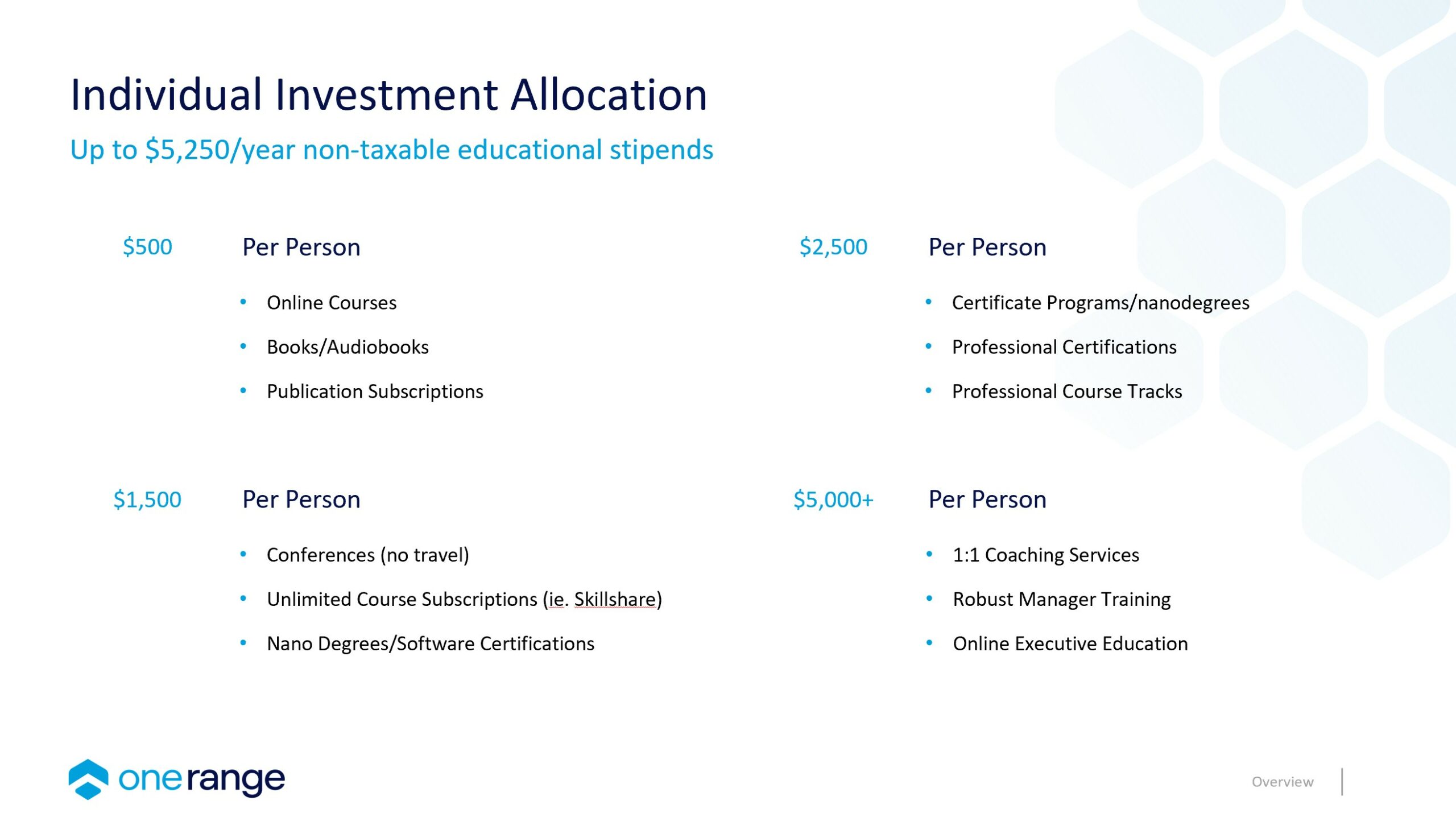Photo by Omid Armin
One of the most common questions about designing a corporate professional development program is how much to allocate for the individual allowance, sometimes called an education stipend or employee investment. Should it be $200 a year? $10,000?
It’s not surprising that L&D leaders are asking this question. Professional development investments (PDIs) are still relatively new – formal programs are only about 10-15 years old in most industries – so there is not a lot of research or publicly available information on the topic. But as more and more companies get into the game – 90% of tech companies now offer some form of PDI – the question of how much to offer has become increasingly important.
The stakes are high: If you offer too little, it won’t feel like a real benefit to employees, especially knowledge workers used to receiving generous perks. Plus, you risk depriving people of the most meaningful, high-impact professional development activities that often come at higher price points. And you will likely fail to create a culture of continuous learning.
On the flip side, if you offer too much, won’t employees just abuse the system? Or spend so much time on continuous education activities that their work suffers?
The big picture: Whatever amount you choose, this is one of the best investments you can make in your people.
Before we get into the nuances of how much to offer, let’s first address this elephant in the room about stipend abuse: There are statistically zero examples of employees misusing PDIs for frivolous or nefarious means.
Surprised? It turns out that when you invest in employees’ professional development, they really appreciate it and don’t want to scam you. Reassuring, right?
In fact, research from the American Society for Training and Development shows that continuing education is one of the strongest investments you can make in your talent: Companies that invest $1,500 or more on employee training average a 24% higher profit margin than companies with lower yearly training investments.
And that’s not even considering the retention savings. According to a LinkedIn Learning Workplace Report, fully 94% of employees say they would stay at their company longer if it invested more in their professional development. On the other hand, it typically costs around $100K to hire a new tech employee, once you factor in the loss of productivity from the job vacancy, training time, ramp up, and recruiting costs – and that doesn’t even include overtime and consulting fees to bridge the gap. It’s clear that investing in your current employees offers major value and ultimate cost savings.
From our perspective, there is virtually no amount of PDI that is “too much” when you weigh the potential ROI gains in productivity, retention, and employee satisfaction. That said, there are some practical considerations to help you signal value, build internal buy-in (and budget), boost utilization, and ensure that high-quality professional development is available to every employee at every level of your organization.
What’s the right amount? The sweet spot is $500 – $5,250.
The average per-employee continuous education investment is $2,500 a year, and we recommend a range of $500 – $5,250 annually (more on this oddly specific upper limit shortly). Stipends should always be allocated annually, as many programs and subscriptions run annually, and it becomes far too complicated to administer a PDI monthly or quarterly.
A minimum of $500 ensures that employees feel valued and have some choice, while a maximum of $5,250 helps drive utilization and prevents employees from being overwhelmed by the paradox of too much choice. It’s also worth noting that $5,250 is the federal limit for providing tax free educational stipends. That means that companies can invest up to $5,250 per employee without that investment being taxed the way a $5,250 increase in compensation would be. And that’s real value, both for companies and employees.
What can you get at different price points?
If you’re wondering where your business should fall along that $500 – $5,250 spectrum, the chart below can help. In the chart, we offer a basic overview of the different types of programs and resources that your employees can take advantage of at increasing annual investment amounts. Check out our blog post “Ten ways to use your professional development stipend” for more information about the activities included in each tier.

PD for all, but not one-size fits all: The value of tiered allowances
While we strongly believe in making continuous education available for every single member of your organization, you don’t have to offer the same stipend to every employee. And in fact, there are some compelling reasons not to. We suggest that companies take a tiered approach that recognizes different needs and rewards continued service with additional PDI value. Here are some of the factors that we suggest businesses consider when designing a tiered PDI program.
Role: Certain roles like engineering require constant skills updates to stay current with new software, programming languages, technology stacks, etc. Consider allocating higher stipends to roles or departments with greater inherent learning needs.
Seniority: The skills required to excel as a manager or high-level executive may require more specialized, high-cost training. For example, programs like coaching, executive education, and expert-led seminars tend to be on the pricier side. However, they are well worth the investment when you consider the disproportionately large impact that executives have on influencing business decisions, setting the right tone across the organization, and leading high-performing teams.
Employee lifecycle: We have found that highlighting professional development as part of your new employee onboarding process is critical to fostering a culture of continuous improvement, building a habit of PD, and supporting your employees’ long-term growth and development. Just as new employees might have unique professional development and upskilling needs that could be addressed with supplemental stipends, people going through major career transitions – for example a shift in job function or a promotion to leadership – may have greater learning needs that warrant additional investment or special PD programs.
Tenure: More and more companies now offer incentives like sabbaticals to their longest tenured employees. So, why not use extra professional development funding as a way to thank your most dedicated employees for their history of service to your organization?
Usage: You might want to consider offering larger stipends to your highest-volume professional development users. By incentivizing people to become “power users,” you help to drive overall PDI utilization (which is only 10-15% at most companies just starting a program) and foster a culture of continuous improvement.
Whether or not you decide to take a formal tiered approach to your PDI program, you should always build flexibility into your program to allow individuals to request additional funds if they can demonstrate a valid need and can show that they will be good stewards of the investment.
The $1,000 club: A trusted approach to building investment in your PD program
If you’re launching a brand new PDI program and you’re still struggling to figure out where your company should fall within that $500 – $5,250 range, we recommend starting with $1,000 per employee and increasing over time. This will help people get used to the practice of building professional development and upskilling into their workflows and enable you to demonstrate program success and ROI.
By offering a more conservative initial amount, you can drive higher utilization and increased demand for additional investment in the program. Then, armed with your impressive data on employee usage, satisfaction, and demand, you’ll be able to quickly dispel any potential concerns and make a compelling case to your executive team to increase your annual allocation.
Beyond the political benefits of demonstrating quick wins to your executive team, there are some real benefits to increasing the PDI amount over time and building goodwill with employees. By taking an incremental approach, you create a perception of growing value and demonstrate that you are responding to employees’ needs.
After all, increasing benefits is one of the best ways to boost employee morale (and, conversely, decreasing benefits is one of the surest ways to kill it). Plus, you can use the data from the initial launch to improve the program and design strategies to help employees get more out of larger stipends, for example by creating “packs” of top resources that they can bundle together.
In short, by taking an incremental approach, you’ll steadily improve your program, demonstrate clear ROI, impress your executives, deliver more value, and generate greater results and higher satisfaction among your employees. What’s not to like about that?
Future directions
The landscape of PDIs remains relatively uncharted territory. As this practice evolves and matures, we’ll continue to conduct research on PDI amounts and share our latest findings and recommendations with you.
We’d love to hear from you! Connect with us on LinkedIn and tell us how you’re tackling this question. Or schedule a consultation to discuss your unique situation. We’d love to help you design an amazing PDI program and choose the right annual allocation for your business.






